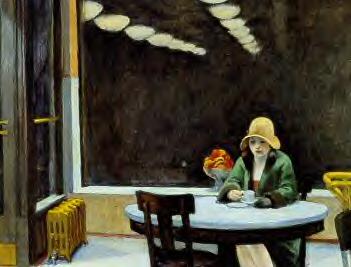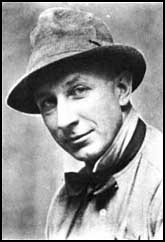
In the period between 1920 to 1929, there were a number of artists, but none of them left an impression like Edward Hopper and George Bellows. They both left impressions through their own style of art. But like other artists during any time period, Hopper and Bellows faced a great deal of problems.
Edward Hopper grew up in the small town of Nyack, New York, and was born on July 22, 1822. he belonged to a middle class family , with his father  being the main source of income by working as a businessman at a dry goods store in Nyack. As hopper grew up so did his interest in the fine arts, and when he graduated high school he hoped to pursue a career in the fine arts. But his parents did not cooperate with his interests because they wanted him to go to the correspondence school of illustrating in new York city. As an obedient son he did as he was told. But as his hate towards illustrating grew, so did his love for the fine arts. During the 18 th and 20 th , there was a movement of American artists who went to Europe and among these artists was hopper. Hopper stayed in Paris with his friend Patrick Henry, who introduced him to French impressionists such as Sisley, Disarro , and Renoir. After his meeting with these artists he began experimenting with pointillism , a form of art using dots to create art work. after 1910, he went back to his old way of life in new york and worked as an illustrator. Martin Lewis influenced hopper through etching , which went well with hoppers background in illustation. From the time between 1915 and 1923,hopper produced a number of etchings. He later gave up his commercial job to focus on his artwork.
being the main source of income by working as a businessman at a dry goods store in Nyack. As hopper grew up so did his interest in the fine arts, and when he graduated high school he hoped to pursue a career in the fine arts. But his parents did not cooperate with his interests because they wanted him to go to the correspondence school of illustrating in new York city. As an obedient son he did as he was told. But as his hate towards illustrating grew, so did his love for the fine arts. During the 18 th and 20 th , there was a movement of American artists who went to Europe and among these artists was hopper. Hopper stayed in Paris with his friend Patrick Henry, who introduced him to French impressionists such as Sisley, Disarro , and Renoir. After his meeting with these artists he began experimenting with pointillism , a form of art using dots to create art work. after 1910, he went back to his old way of life in new york and worked as an illustrator. Martin Lewis influenced hopper through etching , which went well with hoppers background in illustation. From the time between 1915 and 1923,hopper produced a number of etchings. He later gave up his commercial job to focus on his artwork.
George Bellows was born on august 19, 1882. his artwork embodied the urban lifestyles of the new York nightlife. Bellows and his friend Henri organized an exhibition of urban studies in 1908, where Bellows first achieved notice form the public eye. He is known best for painting that portrayed amateur boxing matches and new york city under snowfall. His paintings are created with rough, bright human figures which embodies a sense of motion, and a dark atmosphere which outlines the roughly lain figures with a sense of depth and contrast.
is known best for painting that portrayed amateur boxing matches and new york city under snowfall. His paintings are created with rough, bright human figures which embodies a sense of motion, and a dark atmosphere which outlines the roughly lain figures with a sense of depth and contrast.
Edward Hopper was known as a famous etcher, and was awarded for it numerous times. In an art exhibition in 1924, he sold all eleven watercolor paintings. He is considered a Realist, an artist only seeking to portray the "real in real." But his goal was engraved deep within his paintings. He claimed that he was after himself, that he wa trying to express and portray the "real" in him. In 1964, he stopped working due to an ailment that prevented him from painting for an entire year. At age 83, he painted his last painting "The Two Comedians," his final stroke at the canvas before he died in 1967. Hopper was also famous for paintings such as Nighthawks, Soir Bleu, 1914, 1942, and Girl at the Sewing Machine.
George Bellows was also very famous for his artwork in his time he was well known for works such as Cliff Dwellers, Both Members of This Club, and Shore House Date. These paintings led the artist to be one of the most prominent artists in 1920s, and helped contribute to American Art History.
Like many artists of any time period, they went through many hardships trying to pursue their dreams of being prominent artists. They took many risks trying to improve and maintain their lives as artists. They used art as a means to reach out to their audience and express themselves to the world, and in the end they became an important part of art history.
INTERNET SCOURCES
- "George Bellows.""wikipedia.org." 29 Jan. 2008 <http://en.wikipedia.org/wiki/George_Bellows>
- "Le Blog De Posuto." "posuto.blog.lemonde.fr." 29 Jan. 2008 <http://images.google.com/imgres?imgurl=http://posuto.blog.lemonde.fr/files/2007/07/automat-edward-hopper.1184654291.jpg&imgrefurl=http://posuto.blog.lemonde.fr/2007/07/17/hopper/&h=267&w=351&sz=18&hl=en&start=1&um=1&tbnid=YaUtXMMg32lRsM
BOOK SCOURCES
- Feinstein, Stephen. The 1920s: From the War to Elvis. New Jersey: Enslow Publishers, Inc. 2000.